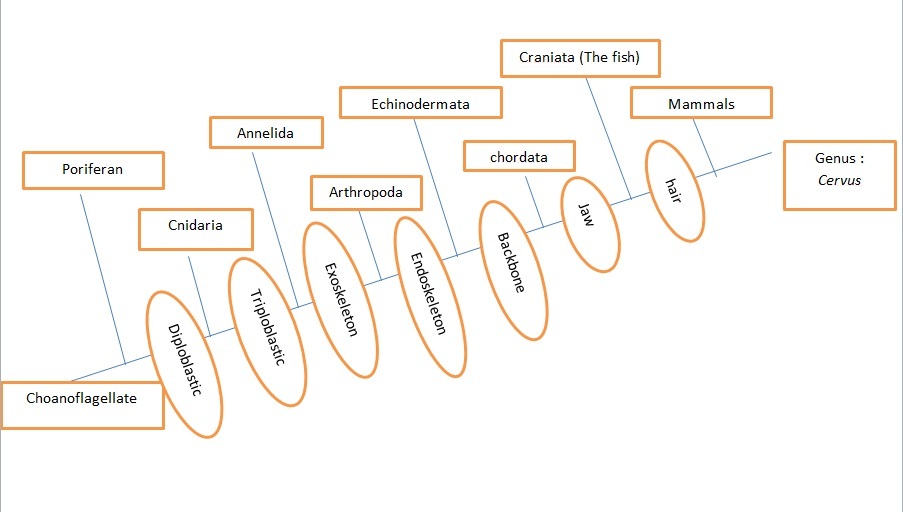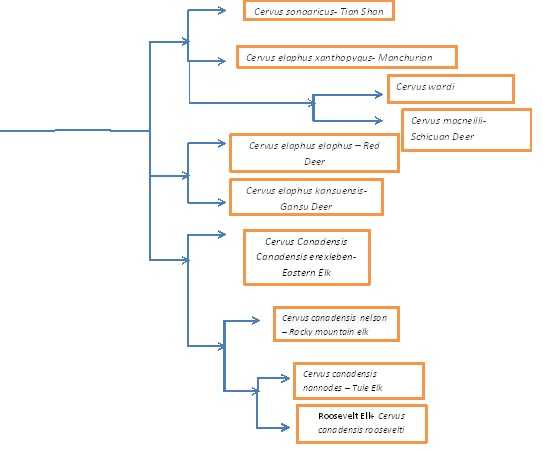The Relationships and Classifications of Roosevelt Elk
 The Elk are in kingdom Animalia because they are
heterotrophic, multicellular, and Eukaryotic. Following that the
elk are classified in
phylum chordate because of the backbone and dueterostomes. Then
elk
are in the class Mammalia because they have hair, their
offspring are developed internally and they have a
well-developed dorsal nervous chord. The order Artiodactyla are hooved
which the elk use to travel great distances . The family they belong to
is the Cervidae family. They belong to this family because they
have antlers. They are in the Cervus genus because they
are considered a type of deer. In Latin the word Cervus
means hart. The definition of hart is an adult deer. The Roosevelt
elk are in the Cervus genus because they are considered a
deer.
The Elk are in kingdom Animalia because they are
heterotrophic, multicellular, and Eukaryotic. Following that the
elk are classified in
phylum chordate because of the backbone and dueterostomes. Then
elk
are in the class Mammalia because they have hair, their
offspring are developed internally and they have a
well-developed dorsal nervous chord. The order Artiodactyla are hooved
which the elk use to travel great distances . The family they belong to
is the Cervidae family. They belong to this family because they
have antlers. They are in the Cervus genus because they
are considered a type of deer. In Latin the word Cervus
means hart. The definition of hart is an adult deer. The Roosevelt
elk are in the Cervus genus because they are considered a
deer.
Roosevelt elk are triploblastic. They have an
endoskeleton, not an exoskeleton. Roosevelt elk have a backbone, a
developed jaw and hair. Their unique characteristics that
differentiate them from other mammals are mainly their antlers and
hooves. These are very unique characteristics that only a few other
mammals have.
The scientific name that is given to the Roosevelt
elk is Cervus canadensis roosevelti. In a literal
translation this comes out to be Roosevelt deer Canada. The
scientific description is that this is a deer from Canada and it is
named after the President Theodore Roosevelt. The person who
discovered this species named it after Roosevelt because at the time
Theodore Roosevelt was an avid conversationalist who wanted to keep
the elk species alive. Because of his determination and drive the
species was named after the 26th president of the United States.
Elk are very closely related to the
red deer. They are in fact so similar that some claim they should be
treated as the same species. This is not surprising though because
of their many shared traits. Some of these shared traits include the
appearance of antlers, their similar diet, their outer covering and
the roaming that both animals exhibit. Both of these species also
use their antlers for defense and for fending of other males from
their mates. During mating season males will use their antlers to
try and show dominance over other males. This is used to show which
male is the most dominant. The strong similarities have shown elk to
be classified closely to the Olgocene genus which contain the
deer(Whitehead 1972). The major difference is that elk are larger is
size than the red deer. The elk are believed to have their common ancestors from
Eurasia. Then, it is believed, that they spread out to fill most
of the niches in Eurasia and North America. The common ancestor
is believed to have been much larger as evidence has pointed to
a reduction of size over time since the beginning of the species
(Red Deer).

Many of the different types of elk are split up because of
different types of DNA. Some of its closest relatives are the:
Cervus elaphus elaphus, Cervus elaphus xanthopygus, the Cervus
elaphus kansuensis,
the Cervus songaricus, the Cervus wardi, and the
Cervus macneilli. All of these animals can be found in the same
genus and actually have very similar characteristics (Murie 1951). The elk even have the same rut time as the red
deer which shows that they are closely related. It is not known
if a deer and a Roosevelt elk can mate so the
major similarities are morphological and cladistical. The
Roosevelt elk has the closet relationship to the Rocky Mountain
elk. This is mainly because the territory of the Roosevelt elk
is close to the territory of the Rocky Mountain elk. When
concluding that these elk had the most similar DNA one can
expect that they share a common ancestor that also lives in
North America at one time.
Many once thought that Roosevelt elk
and Rocky mountain elk were the same species. The elk were soon
compared side by side and found to have many differences.
The major difference between the Roosevelt elk and the Rocky
mountain elk is that the Roosevelt elk is typically bigger
topping out the scales at 1,000 pounds. They also have larger
antlers which can also be another defining characteristic. Not
only do Roosevelt elk have larger antlers but actually larger
skulls. This is understandable because of the larger size. Another
morphological difference is the color change between the two types
of elks. The Roosevelt elk has a darker coloration to it than is
close relative the Rocky mountain elk. The
last major difference is actually where they live. They live in
a separate environment than do the rocky mountain elk which has
caused differences in their DNA.
Most researchers had long thought that the
Roosevelt elk was closest to the Rocky mountain elk in the
phylogenetic tree. Instead Roosevelt elk are most similar to the
Tule elk when comparing DNA(Meredith 2007). This has brought about
the relationship shown above where the Roosevelt elk is closest to
the Tule elk when put on the phylogenetic tree.
Back to Home
Next to Habitat
 The Elk are in kingdom Animalia because they are
heterotrophic, multicellular, and Eukaryotic. Following that the
elk are classified in
phylum chordate because of the backbone and dueterostomes. Then
elk
are in the class Mammalia because they have hair, their
offspring are developed internally and they have a
well-developed dorsal nervous chord. The order Artiodactyla are hooved
which the elk use to travel great distances . The family they belong to
is the Cervidae family. They belong to this family because they
have antlers. They are in the Cervus genus because they
are considered a type of deer. In Latin the word Cervus
means hart. The definition of hart is an adult deer. The Roosevelt
elk are in the Cervus genus because they are considered a
deer.
The Elk are in kingdom Animalia because they are
heterotrophic, multicellular, and Eukaryotic. Following that the
elk are classified in
phylum chordate because of the backbone and dueterostomes. Then
elk
are in the class Mammalia because they have hair, their
offspring are developed internally and they have a
well-developed dorsal nervous chord. The order Artiodactyla are hooved
which the elk use to travel great distances . The family they belong to
is the Cervidae family. They belong to this family because they
have antlers. They are in the Cervus genus because they
are considered a type of deer. In Latin the word Cervus
means hart. The definition of hart is an adult deer. The Roosevelt
elk are in the Cervus genus because they are considered a
deer. 